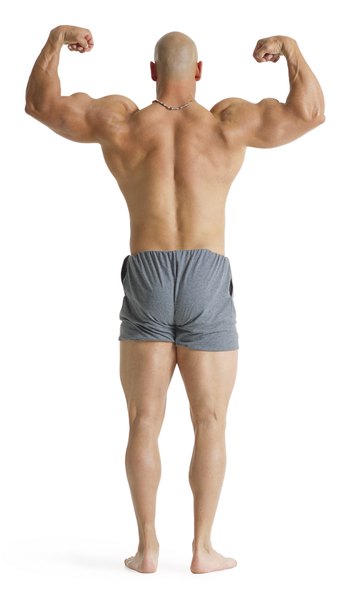Antagonists of the Shoulder Abductor

Abducting your shoulder means lifting your arm out to the side. Several muscles can abduct the shoulder. The opposite, or antagonistic, action of bringing your arm toward the side of your body is called adduction. The adductor muscles are the antagonists of the abductors and include the latissimus dorsi, the pectoralis major and the teres major, along with several accessory muscles.
Latissimus Dorsi
The latissimus dorsi, a broad sheet of muscle that covers much of the lower back, is a powerful adductor of the shoulder. It originates from the sacrum, the upper rim of the pelvis, the lower part of the spine and the connective tissue of the lower back, and it inserts into the upper arm bone, or humerus. When it contracts, it pulls the humerus toward the side of the body, as in the action of a pullup.
Pectoralis Major
The pectoralis major muscle also adducts the shoulder. A prominent muscle of the chest, it ties the sternum, cartilage of the upper ribs and the collarbone to the front of the upper arm. When it contracts, it pulls the upper arm inward toward the chest. You use the pectoralis major in a pushup or a dumbbell fly. Since it's an antagonist of the shoulder abductors, an overly contracted pectoralis major can limit your ability to open your arms to the side.
Teres Major and Minor
The teres major is a small muscle that assists the latissimus dorsi in its action of adducting the shoulder. It originates at the bottom tip of the shoulder blade, or scapula, and inserts onto the front of the arm bone. It pulls the humerus toward the scapula, adducting the shoulder. Directly above the teres major is the teres minor, one of the rotator cuff muscles. It runs from the scapula across the back of the humerus and is a secondary adductor of the shoulder.
Accessory Adductor Muscles
Several other muscles assist the major adductors of the shoulder. The short head of the biceps, which runs from a prominence on the front of the scapula to the forearm, helps to adduct the shoulder, although its primary job is to flex the elbow and turn the palm up. The coracobrachialis originates from the same tendon as the short head of the biceps and inserts onto the inner humerus. It also assists with adducting the shoulder.
References
- Anatomy of Movement; Blandine Calais-Germain
- Kinesiology of the Musculoskeletal System: Foundations for Rehabilitation; Donald A. Neumann
Writer Bio
Joe Miller started writing professionally in 1991. He specializes in writing about health and fitness and has written for "Fit Yoga" magazine and the New York Times City Room blog. He holds a master's degree in applied physiology from Columbia University, Teacher's College.
